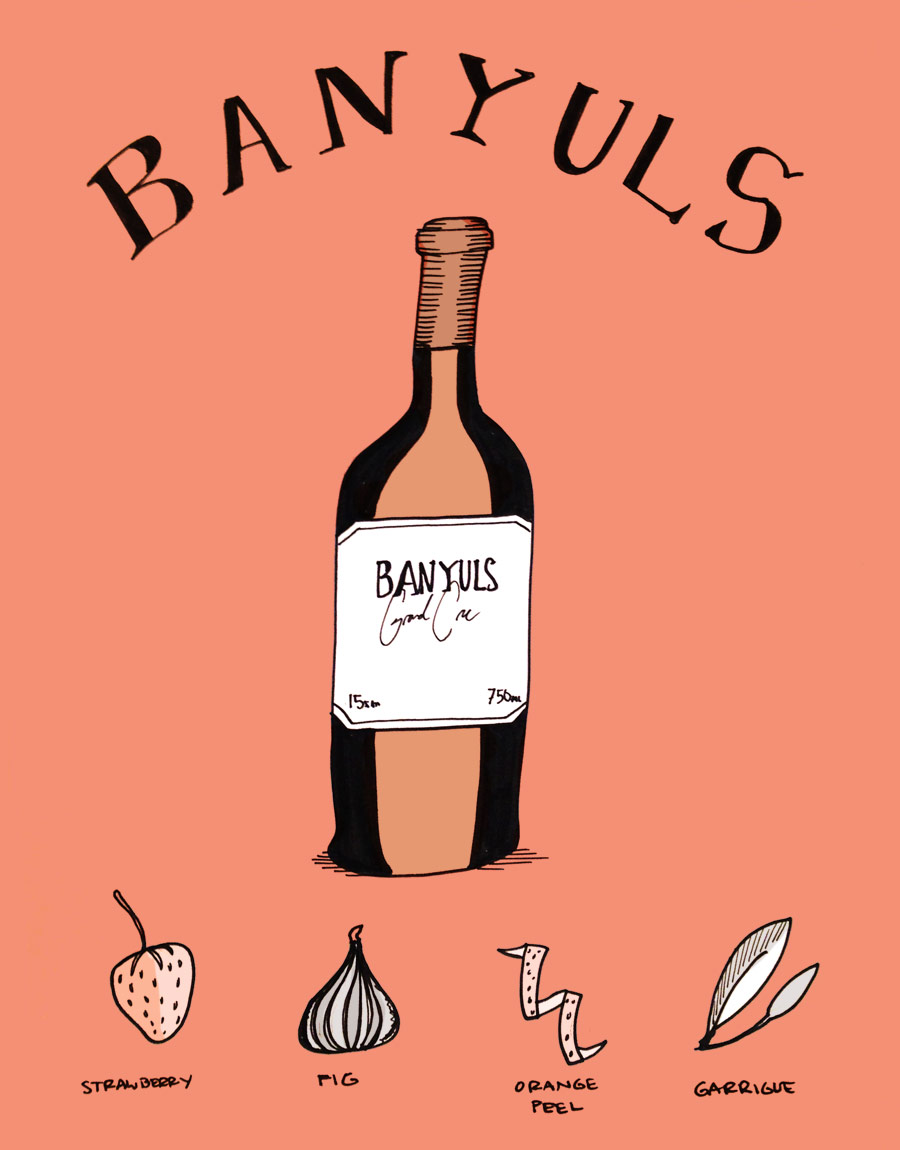As humans, our sense of smell is not only closely linked to our sense of taste, but it also directly connects to the parts of our brains that manage both emotion and memory. Smells of all kinds have the power to conjure up vivid imagery and can transport us back in time — for example, my grandmother’s cellar has the most suffocating, musky, balmy odor. As repulsive as this might be to some, it conjures up fond, warm memories of being a young child with my family together.
So, for the sake of strong memories (and to blow your mind), I’d like to introduce you to a few remarkable wines with highly unique aromas. These are wines that are excellent for people who want to strengthen their aromatic repertoire. If you haven’t tasted them yet, try one over the winter (each of these wines will last open for around a month) and it will change the way you think about wine… forever.
Banyuls Rouge
On the French side of the border between France and Spain lies Banyuls in Roussillon, an intriguing, mountainous wine-growing zone where head-trained Grenache vines grow on rugged schist soils that look out towards the Mediterranean Sea. The Grenache is used for both dry (Couillère AOP) and semi-sweet fortified wines (Banyuls AOP), of which the latter is a centuries-long tradition in the region. Grapes are picked ripe and partially fermented (to approximately 6% alcohol by volume) at which point, eau de vie (neutral grape spirit) is added, creating a richly textured, naturally grape sweet, fortified wine with approximately 15% ABV. The French call this winemaking method VDN or Vin Doux Naturel (e.g. “naturally sweet wine”).
How it tastes: Great Banyuls Rouge wines offer lifted floral aromas of strawberry, dried cherry, fig, a touch of coffee, and orange peel, as well as subtle aromas of wet schist stones and minty, sage-like herbs (aka “garrigue”). Even though wines may have 50 or so g/L of residual sugar, they taste balanced due to moderately grippy tannins. To make things even more appealing, Banyuls Rouge might just be the most perfectly suited wines for pairing with chocolate. Mais, oui!
Expect to spend: $20–$30 for a great bottle of Banyuls Rouge
Oloroso Sherry
The Sherry craze over the past 5 years has inspired a new segment of wine drinkers who appreciate the delicate, pale, somewhat salty wines of Fino and Manzanilla Fina Sherry. This is not the wine we’re talking about. Oloroso Sherry is an entirely different beast.
During the production of Sherry, newly fermented wines either go through a biological aging process or an oxidative aging process. Fino and Manzanilla Fina develop a film of yeast (called “flor”) on the surface of the wine, which protects the wine from oxidation and creates the wine’s delicate flavor and aroma. Oloroso, on the other hand, is made in a way that does not permit the flor to grow, causing the wines to oxidize over a long period of time and creating a very intensely flavored wine.
How it tastes: Oloroso Sherry has a deep mahogany color that results from long-term barrel aging, as well as a rich aroma of walnuts, woodsy herbs, coconut, almonds, hazelnuts, raw cocoa nibs, and burnt orange peel. The wines range in style from semi-sweet to completely dry, and some of the higher rated wines have an added touch of Pedro Ximénez wine (a very sweet wine) which adds subtle complexity and serious body to Oloroso. The drier styles of Oloroso Sherry are perfect when paired with paprika spiced Marcona almonds and aged cheeses (particularly Gouda with its subtly smoky flavors).
Expect to spend: $20–$40 for an exceptional Oloroso Sherry

Vin Jaune
If you drive east from the pristine vineyards in Burgundy, France you’ll find yourself in the rolling hills of Jura around the city of Arbois. It’s here where one of France’s more intriguing wines is produced, even if it’s rarely talked about. Vin Jaune or “yellow wine” is made with a living legend grape called Savagnin (“sav-van-yin” that’s Savagnin, not Sauvignon Blanc) which DNA analyses have shown to be a player in many of the world’s most important wines, from Pinot to Cabernet Sauvignon. This white wine is made to be quite acidic (a pH of 3–3.1!) and is aged in tanks for many months. After a year or so of aging, during which time the wines go through Malolactic Fermentation and the acids become softer and creamier, the liquid is transferred to old barrels with a little bit of air space at the top. This open space lets a film of yeast grow on the top layer of the wine (called voile, which is similar to Sherry’s flor) and this is what gives the wine its distinctive taste.
How it tastes: The aromas are highly intense in vin jaune and might not be recommendable for budding enthusiasts because it’s so arresting. Imagine brazil nuts, dried pear, rose pastille candy, fennel seed, and pear skin with grappa-like intensity. The taste is smooth, nutty, creamy, and slightly acidic, all at the same time. For a wine geek, this wine will have you scratching your head and wanting to take another sip in an attempt to understand it. Vin Jaune matches well with pungent, soft, washed rind cheeses and dried fruits which will balance out the intensity of this wine.
Expect to spend: $25–$45 for a great bottle of vin jaune


